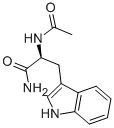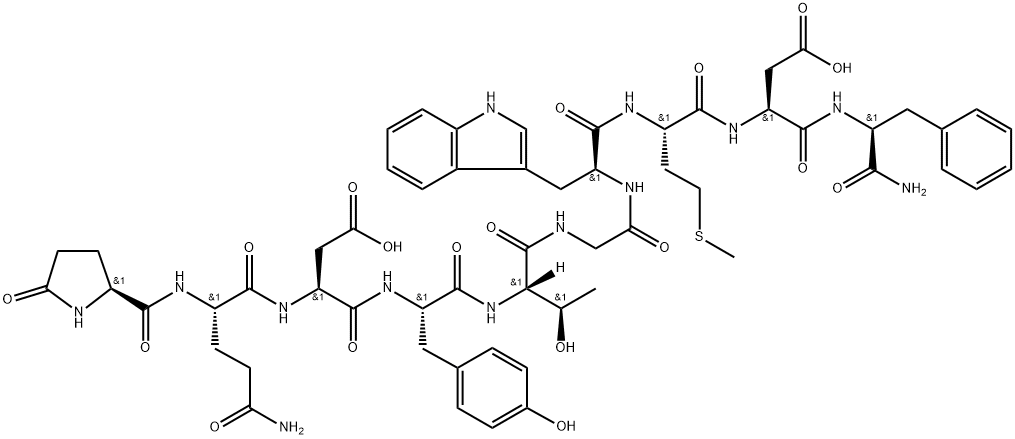CAERULEIN
Synonym(s):[Tyr(SO3H)4]Caerulein;Caerulein Sulfated;Cerulein;Ceruletide;pGlu-Gln-Asp-Tyr(SO3H)-Thr-Gly-Trp-Met-Asp-Phe-NH2
- CAS NO.:17650-98-5
- Empirical Formula: C58H73N13O21S2
- Molecular Weight: 1352.4
- MDL number: MFCD00076478
- SAFETY DATA SHEET (SDS)
- Update Date: 2024-11-17 19:25:39

What is CAERULEIN?
Absorption
Absorbed following intravenous administration.
Originator
Ceosunin,Kyowa Hakko,Japan,1976
The Uses of CAERULEIN
Caerulein is a ten amino acid oligopeptide that stimulates smooth muscle and increases digestive secretions. It is similar in action and composition to cholecystokinin. It stimulates gastric, biliary, and pancreatic secretion; and certain smooth muscle. It is used in paralytic ileus and as diagnostic aid in pancreatic malfunction. It is used to induce pancreatitis in experimental animal models.
The Uses of CAERULEIN
Stimulant (gastric secretory).
Indications
Caerulein is used in the treatment of paralytic ileus and as diagnostic aid in pancreatic malfunction.
Background
Caerulein is a specific decapeptide similar in action and composition to the natural gastrointestinal peptide hormone cholecystokinin. It exerts stimulatory effects on the gastric, biliary, and pancreatic secretion, as well as on certain smooth muscles.
Definition
ChEBI: A decapeptide comprising 5-oxoprolyl, glutamyl, aspartyl, O-sulfotyrosyl, threonyl, glycyl, tryptopyl, methionyl, aspartyl and phenylalaninamide residues in sequence. Found in the skins of certain Australian amphibians, it is an analogue of the gastrointes inal peptide hormone cholecystokinin and stimulates gastric, biliary, and pancreatic secretion. It is used in cases of paralysis of the intestine (paralytic ileus) and as a diagnostic aid in pancreatic malfunction.
Manufacturing Process
The tetrapeptide, L-pyroglutamyl-L-glutaminyl-L-aspartyl-L-tyrosine-azide (I),
is condensed with the hexapeptide, L-threonyl-glycyl-L-tryptophanyl-L-methionyl-L-aspartyl-L-phenylalaninamide (II), having the hydroxyl of the
threonyl radical blocked by an acyl radical in a suitable solvent, such as
dimethylformamide, to obtain the decapeptide, L-pyroglutamyl-L-glutaminyl-L-aspartyl-L-tyrosyl-L-threonylglycyl-L-tryptophanyl-L-methionyl-L-aspartyl-Lphenylaninamide (III) having the hydroxy group of the threonyl radical
blocked by an acyl radical. The decapeptide (III) is treated, at low
temperature, with the complex anhydrous pyridine sulfuric anhydride finally to
obtain the decapeptide, L-pyroglutamyl-L-glutaminyl-L-aspartyl-L-tyrosyl-L-threonyl-glycyl-L-tryptophanyl-L-methionyl-L-aspartyl-L-phenylalaninamide
(IV) having the phenolic group of the tyrosyl radical protected by a sulfate
radical and the hydroxyl of the threonyl radical protected by an acyl radical.
Finally, by mild alkaline hydrolysis of the decapeptide (IV) one obtains the
decapeptide product.
Therapeutic Function
Stimulant (gastric secretory)
Hazard
A poison.
Pharmacokinetics
Caerulein is a specific decapeptide similar in action and composition to the natural gastrointestinal peptide hormone cholecystokinin that stimulates gastric, biliary, and pancreatic secretion. It also exerts stimulatory actions on certain smooth muscles.
Safety Profile
A poison by subcutaneous route. When heated to decomposition it emits toxic vapors of NOx and SOx
Metabolism
Not Available
storage
Store at -20°C
Properties of CAERULEIN
| Melting point: | 224-226° (dec) |
| alpha | D20 -26° (c = 1 in DMF) |
| Density | 1.464±0.06 g/cm3(Predicted) |
| storage temp. | Sealed in dry,Store in freezer, under -20°C |
| solubility | 0.05 M ammonium hydroxide: 1 mg/mL, clear, colorless |
| form | Solid |
| pka | -4.17±0.18(Predicted) |
| color | White to Off-White |
| Water Solubility | Soluble to 1 mg/ml in water |
| Merck | 13,2015 |
| BRN | 5422487 |
Safety information for CAERULEIN
Computed Descriptors for CAERULEIN
| InChIKey | YRALAIOMGQZKOW-HYAOXDFASA-N |
New Products
(S)-3-Aminobutanenitrile hydrochloride 4-Methylphenylacetic acid N-Boc-D-alaninol N-BOC-D/L-ALANINOL Tert-butyl bis(2-chloroethyl)carbamate 3-Morpholino-1-(4-nitrophenyl)-5,6-dihydropyridin- 2(1H)-one Furan-2,5-Dicarboxylic Acid Tropic acid 1-Bromo-3,5-Di-Tert-Butylbenzene S-2-CHLORO PROPIONIC ACID ETHYL ISOCYANOACETATE 2-Bromo-1,3-Bis(Dimethylamino)Trimethinium Hexafluorophosphate 4-IODO BENZOIC ACID 3-NITRO-2-METHYL ANILINE 1-(2,4-DICHLOROPHENYL) ETHANAMINE (2-Hydroxyphenyl)acetonitrile 4-Bromopyrazole 2-(Cyanocyclohexyl)acetic acid 4-methoxy-3,5-dinitropyridine 1-(4-(aminomethyl)benzyl)urea hydrochloride 2-aminopropyl benzoate hydrochloride diethyl 2-(2-((tertbutoxycarbonyl)amino) ethyl)malonate tert-butyl 4- (ureidomethyl)benzylcarbamate Ethyl-2-chloro((4-methoxyphenyl)hydrazono)acetateRelated products of tetrahydrofuran








You may like
-
 Caerulein CAS 17650-98-5View Details
Caerulein CAS 17650-98-5View Details
17650-98-5 -
 2033-24-1 98%View Details
2033-24-1 98%View Details
2033-24-1 -
 1975-50-4 98%View Details
1975-50-4 98%View Details
1975-50-4 -
 2-HYDROXY BENZYL ALCOHOL 98%View Details
2-HYDROXY BENZYL ALCOHOL 98%View Details
90-01-7 -
 2-Chloro-1,3-Bis(Dimethylamino)Trimethinium Hexafluorophosphate 221615-75-4 98%View Details
2-Chloro-1,3-Bis(Dimethylamino)Trimethinium Hexafluorophosphate 221615-75-4 98%View Details
221615-75-4 -
 61397-56-6 CIS BROMO BENZOATE 98%View Details
61397-56-6 CIS BROMO BENZOATE 98%View Details
61397-56-6 -
 14714-50-2 (2-Hydroxyphenyl)acetonitrile 98+View Details
14714-50-2 (2-Hydroxyphenyl)acetonitrile 98+View Details
14714-50-2 -
 118753-70-1 98+View Details
118753-70-1 98+View Details
118753-70-1